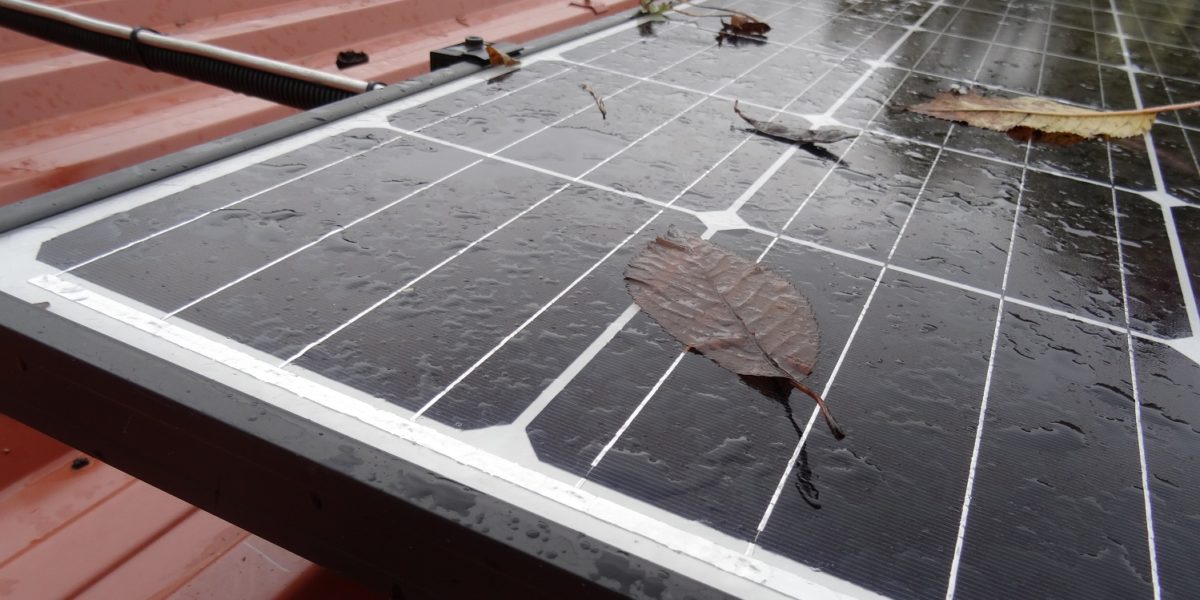In this case, insulation faults in individual connectors of 20 module strings. Individual insulation failures are often difficult to detect in monitoring. And when insulation problems are suspected in the system, it is an additional challenge to pinpoint them precisely. In the following hypothetical case, Enovos would send a technician to the plant to examine strings and modules individually.
The plant: a 1 MW commercial flat-roof system from 2010, in Germany. The crystalline modules are oriented with a
20 degree inclination to the south. The system is equipped with 40 multi-string inverters. In monitoring, five strings are combined for each inverter.
The monitoring system reports: the ease with which insulation faults can be detected in monitoring depends, among other things, on the type of inverter used. Some inverters provide direct insulation values, others simply switch off when the value falls below a certain limit. The system described here uses inverters that do not measure insulation values. The result is that the monitoring first indicates reduced performance in the affected inverter when compared with the other inverters.
A closer look at the monitoring data shows: In the yield curves of the affected strings, isolated failures of entire inverters and all of the connected strings can be seen. This is especially the case in the early morning hours, but sometimes occurs at other times of day as well. This effect occurred relatively infrequently in summer but now that fall has arrived it is happening more often.
The hypothesis: The time at which the inverters fail may indicate one or more insulation faults. This is indicated on the one hand by the delayed start of the system in the morning hours when dew and moisture cover the modules, cables, and connectors, and on the other hand when rain reaches the affected area with the insulation problem. In order to determine the latter, the yield curves of the individual strings and inverters have to be compared with corresponding weather data.
Identifying the fault and the affected modules: Because insulation faults cause a reduction in yield and pose a potential safety risk (in extreme cases due to arcing), the operator decides to address the problem. A technician has to go to the plant. If the faults cannot be detected with the naked eye, it becomes complicated. After all, the insulation faults only occur at certain times, such as in wet and humid weather, and they can only be measured then. This means that the technician has to measure the individual strings and modules at the times when problems were detected during monitoring; in the early morning hours, for instance. Because the technician is in the plant at the right time, the detective work can begin. First, they can set to work on all of the strings of the affected inverters individually and measure the insulation of the string at the inverter. Each time, they have to unplug the connector and insert the insulation measuring device. A single reading takes about two minutes to record. Added to this is the time spent on the roof walking between the various inverters.

Photo: Enovos
Enovos Renewables O & M GmbH, or Erom for short, is a classic manufacturer-independent service provider for technical operations management. Head of Operations & Maintenance is Richard Rath. From its headquarters in Berlin, photovoltaic systems in Berlin and in the metropolitan area of Brandenburg are fully managed by their own staff. Facilities in other locations and abroad are supplied by local partners. The control room works with all standard monitoring systems. Erom is the O & M department of the former Q-Cells. In the meantime, O & M contracts of Solon also have been taken over. The portfolio currently comprises 460 megawatts.
Results of the investigation: Once the affected connectors have been identified, they are quickly replaced. This eliminates the occasional yield losses due to insulation faults. The plant owner no longer has to worry about plant safety and thus fulfils their obligation as operator.
Effort of troubleshooting in this case
Key troubleshooting data:
estimate of the cost of troubleshooting upon detection of decreased performance in monitoring: One workday.
Estimation of the cost of repair:
One workday and small parts.
pv magazine troubleshooting series:
- What happens when… bypass diodes fail?
- What happens when… several module strings fail?
- What happens when…modules get dirty?
If you are interested in participating in similar cost estimates or have suggestions for a more efficient handling of the faults, we look forward to receiving an e-mail from you: Please contact michael.fuhs@pv-magazine.com (subject line: “troubleshooting”).
This content is protected by copyright and may not be reused. If you want to cooperate with us and would like to reuse some of our content, please contact: editors@pv-magazine.com.



By submitting this form you agree to pv magazine using your data for the purposes of publishing your comment.
Your personal data will only be disclosed or otherwise transmitted to third parties for the purposes of spam filtering or if this is necessary for technical maintenance of the website. Any other transfer to third parties will not take place unless this is justified on the basis of applicable data protection regulations or if pv magazine is legally obliged to do so.
You may revoke this consent at any time with effect for the future, in which case your personal data will be deleted immediately. Otherwise, your data will be deleted if pv magazine has processed your request or the purpose of data storage is fulfilled.
Further information on data privacy can be found in our Data Protection Policy.